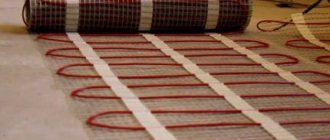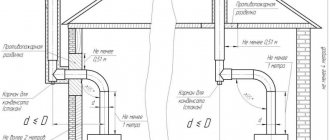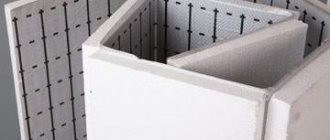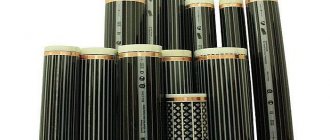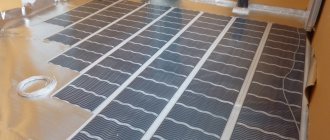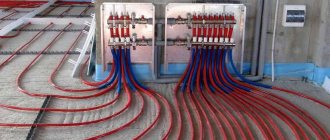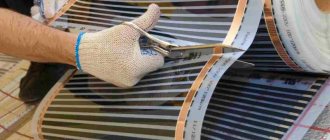Linoleum is a relatively inexpensive and easy-to-install floor covering. But it does not always tolerate heating well. Therefore, when choosing a warm floor for linoleum, you need to focus on a number of factors. It’s worth familiarizing yourself with these guidelines, don’t you agree?
We will tell you which version of the floor heating system is best to choose for installation under a laminate flooring. Here you will learn how to install it, what technological rules should be followed during assembly. Taking into account our recommendations, you can arrange a comfortable space for living with your own hands.
Choosing the right brand of linoleum
There is an opinion that linoleum is a completely synthetic floor covering that, when heated, releases chemicals hazardous to health, such as phenol.
Linoleum is also reproached for its poor ability to withstand heat. When exposed to high temperatures, the coating may noticeably deform.
Marmoleum is a type of linoleum made from natural materials. This coating looks great and goes well with heated floors.
Finally, the material was originally created not to transfer heat, but to protect from the cold penetrating from below. All this is true, but only partly. Linoleum is easy to install and moderate in cost, which is why it remains an extremely popular floor covering.
Modern technologies and developments have allowed manufacturers to create new types of linoleum. Among them there are those that perfectly transfer heat, tolerate moderate heat without compromising their appearance and do not emit any dangerous fumes.
There are five main types of linoleum:
- alkyd or griftal;
- nitrocellulose, also known as colloxylin;
- relin or rubber;
- vinyl, or rather PVC;
- natural, known as marmoleum.
Without going into details of the production technology, we can immediately note that the first three options are categorically not suitable for use with heated floors. All of them react poorly to heat, and Relin is not at all suitable for use in residential areas.
Image gallery
Photo from
Choosing linoleum in a specialized market
Acceptable marmolium
Linoleum with thermal insulation backing
Dry screed for laying the coating
The most popular version of linoleum is its PVC version. This coating is very diverse in design and thickness, relatively safe, and has a pleasantly reasonable price. After installation, vinyl covering almost always emits a not particularly pleasant characteristic odor, which dissipates over time.
However, PVC linoleum is not dangerous; it is suitable for premises where people live. When purchasing, it is recommended to study the labeling of the material; there should be a mark on the packaging stating that this coating is intended for installation on underfloor heating systems.
For example, ordinary linoleum can be equipped with an additional layer of heat-insulating material, which is completely unnecessary over a heated floor.
Not all linoleum is suitable for laying over underfloor heating systems. The markings on the flooring packaging will help you choose the right material (+)
Natural linoleum, also known as marmoleum, is a cutting-edge word in the flooring market. The material contains exclusively natural ingredients, such as crushed cork bark, pine resin and linseed oil, powdered limestone and natural dyes.
Of course, when heated, such material cannot emit any harmful substances, only natural fumes. Marmoleum is sensitive to strong heat, so the issue of choosing a temperature regime for such a coating must be approached very responsibly. However, this is also true for vinyl materials.
Marmoleum can only be blamed for its substantial price, but the high wear resistance and safety of the material fully justify such costs. Marmoleum does not change color over time and also effectively resists fire.
When choosing linoleum for a warm floor, you need to pay attention to the thickness of the material. A coating that is too thin will expose all the unevenness of the base; an excessively thick material will reduce the efficiency of heating the room.
Questions
What happens if you install a more powerful IR heated floor than recommended (for example, 240 W sq./m)?
This will cause negative consequences. Due to more intense heating, linoleum can become vulnerable to tearing and soft, and begin to move away from the base and expand. The most dangerous thing is that in the places where the thermal film is laid, the release of harmful substances will begin in fairly large volumes.
Is it possible to connect two heated floors to one thermostat?
Can. But you need to take into account their total power: it should not exceed the power for which the regulator is designed (3-3.2 kW). It is also worth understanding that only one floor temperature sensor comes from the regulator. If the rooms differ greatly in heat loss from each other, then the same temperature will not be achieved. Therefore, this connection is recommended to be used exclusively for large areas in one room, or adjacent ones, without a door partition.
Is it possible to connect two heated floors, cable and film, to one thermostat?
It is forbidden. They have different performance characteristics that require individual adjustment.
I set the recommended temperature, but the floor is not warm enough, only +28 degrees. Maybe the film is not working properly?
The floor is working correctly. It is the temperature of + 28 degrees that guarantees the energy efficiency of the IR floor. If you select a higher temperature, the energy efficiency will become negligible. If you think that the floor is not warm enough, check its heating with your hand and you will make sure that it warms up as it should. The linoleum surface should not be hot. If you want to get hot air in your house, you should think about additional heating for the walls and ceiling. But in any case, it is the warm floor that will help you achieve the recommended indicators.
Preparing to lay heated floors
Before starting installation, you need to carefully prepare for the work. On a regular sheet of paper, you should draw up a plan of the room, marking on it the places in which stationary pieces of furniture or large household appliances that fit tightly to the floor will be installed. There is no point in laying infrared film here.
Strips of infrared film are laid end-to-end along the length of the room. This will reduce the number of connections of individual strips and facilitate the installation of heated floors
Then they draw up a plan for laying the film strips. The fewer cutting lines there are, the fewer connections will be needed, and the easier the installation will be. Therefore, strips of film are laid along the long side of the room. Once the plan is drawn up, you can calculate the length of the film and the number of connectors needed for installation. The plan should also indicate the installation locations of temperature sensors and a thermostat.
The delivery package for a heated film floor under linoleum usually includes infrared film and connectors, which are supplied in two pieces, temperature sensors and a thermostat, as well as bitumen tape, which acts as an insulator.
Additionally you will have to purchase:
- electrical cable;
- thermal insulation material;
- film for waterproofing the base;
- contactors (for work with high power systems).
To connect a film floor, a copper cable with a cross-section of at least 1.5 square meters is usually used. mm. As a waterproofing material, you can put a layer of polyethylene of at least 0.1 mm. The list of thermal insulation materials that are suitable for film flooring is quite extensive.
To install an infrared floor yourself, you will need the most common tools: pliers, a screwdriver, a mounting knife, tape, a tape measure, scissors, etc.
You can use extruded polystyrene foam, cork materials, liquid composites, etc. Foamed polyethylene or laminated isolon is successfully used under linoleum.
In any case, you should study the labeling of the heat insulator to make sure that the material can be used with heated floors. The use of heat-insulating material with a metal foil coating is unacceptable.
The most complex tool that will be needed during installation is a special device for crimping contact connectors. But with some skill, ordinary pliers are suitable for this.
In addition, you need to prepare a screwdriver and wire cutters, scissors and a mounting knife for cutting the film, as well as insulating materials, a hammer, etc. Thus, the installation of a warm infrared floor for laying linoleum can be done using the most common construction tools.
Connection
The film must be cut based on the size and configuration of the room. Heating systems are not installed under furniture. The film is supplied in rolls, the width of which is standard and is 50 cm. Manufacturers provide the ability to cut it in the right places to make pieces of the heating film of the required size. Some make a dotted line along which a cut can be made at a distance of 50 cm, others - 10 cm.
Having cut pieces of the appropriate length, you need to connect the power wires to them. There are contacts on both sides of the film. These are silver strips to which metal terminals are connected. The clamps must pierce the contacts to create a proper connection.
When the terminals are connected, a wire is connected to them. Usually all the necessary components are sold as a kit. Many manufacturers supply additional parts separately.
System Installation Guide
If the film layout plan has already been drawn up, and all materials and tools have already been prepared, you can begin work by preparing the base. It needs to be made clean and as smooth as possible.
The film itself is very thin, less than 0.5 mm. If the material is laid on an uneven base, the heating elements will be subjected to additional stress, which may cause damage.
The base for infrared heated floors must be clean and level. Usually it is enough to carry out only minor repairs to the surface, but sometimes it is necessary to pour a fresh screed
In case of extensive damage, additional work should be carried out to level the base, for example, pour a new screed over the old base. But if the subfloor is initially fairly level, it is enough to clean it from dirt and dust and eliminate individual differences in height, if necessary.
A layer of thermal insulation material is placed on the prepared base. If it is a rolled material, then usually the strips are laid end-to-end and the joints are secured with tape. The insulation should lie very evenly; if the base is properly prepared, problems in this regard usually do not arise.
Cutting the infrared film into strips of suitable length is a crucial moment. There are special places for cuts, indicated by a dotted line. If you cut in other places, the film will probably be damaged.
The places intended for cutting the infrared film are indicated on the material with dotted lines. Do not neglect these instructions so as not to damage the system
The narrowest piece of film cut along the dotted line can be less than 20 cm, and the longest can be about 8 meters. This allows you to make strips of the required length in the required quantity. The fewer cuts, the easier the installation.
Cut strips of infrared film are laid out according to plan on top of a layer of thermal insulation material. In this case, the copper strip must be placed with the side up indicated by the manufacturer in the instructions.
The film should be carefully leveled so that it fits snugly to the base. The presence of an air gap between the heating strips and thermal insulation is unacceptable. After the film strips are laid, you can begin installing the contacts.
The connecting clamp is installed on the copper strip and clamped using a special tool or ordinary pliers. The connectors should be installed in such a way that one part of the element is between the layers of the film shell and attached to the copper busbar, and the second part is outside.
The connector is installed so that part of it is between the layers of the infrared film shell. To fix the connection, you can use ordinary pliers
After this, you need to hide under pieces of bitumen insulation all the places where the bimetallic bus is connected to the power line. All strip contacts that are not connected to wires also need insulation. They are located on the side opposite the connection side.
After the insulation work is completed, you should use tape to fix the position of the film on the floor so that it does not move while laying the linoleum.
When laying infrared film, all contact points must be insulated with bitumen tape, which is included in the kit. Bitumen insulation is glued separately at the top and bottom; kinks are not allowed
Now you need to install the thermostat. It is usually hung on the wall in an easily accessible place. The connection must be made in accordance with the diagram. Inexperienced electricians should consult a specialist at this stage. Thermal sensors are placed under the film and connected to the thermostat with wires.
To hide the cable leading from the thermostat, you can make a groove in the wall. If the repair has already been completed, the cable is laid on top of the wall and covered with a decorative plastic box. Below, a plinth is used to disguise the cable. The edges of the cable providing power are connected using connectors and pressed with pliers.
To ensure that the installation sites of the temperature sensor and the wire connected to it do not stand out on the film of the infrared heated floor, a semblance of a channel and recesses of a suitable shape are carefully cut out in the heat-insulating material
Then the connection point is isolated. Thickening will appear where the insulation is installed, as well as where the temperature sensor is attached to the film. They can complicate further installation of the floor covering.
To prevent this from happening, you should use a mounting knife to cut out recesses in the layer of heat-insulating material. This will eliminate the difference in height, and the surface of the film will become even again.
At this point, the installation of heated floors under linoleum can be considered complete; all that remains is to check the characteristics of the system before installing the floor covering. To do this, power is supplied to the film. First, you need to use an electrical tester to verify the reliability of the insulation; you should check the absence of voltage in each isolated area.
This diagram clearly shows the procedure for connecting the film floor to the power supply. The thermostat should be installed in a place accessible for maintenance
After this, the degree of heating of each individual strip is checked. If there is no heat, or if some areas are colder or hotter than others, it means the installation was done incorrectly. Possible errors should be found and eliminated.
Problems usually arise from such violations as laying film strips not end-to-end, but overlapping; such a position of the heating material is unacceptable. You should also not cut the film too close to the copper busbar, as this may cause insulation damage. Complete or partial lack of insulation is one of the most common causes of underfloor heating failure.
Installation of a thermostat
For this device, a recess is made in the wall. The thermostat is installed next to the outlet. A round hole is drilled for it, as for a regular switch. On the reverse side of the thermostat there are several terminals (the number depends on the model).
Two of them are intended for connecting a remote sensor. Two more are needed to connect the wires to the infrared film. There are also terminals for connecting the phase and neutral of the network. Some models also have a seventh terminal. It is intended for grounding connection.
Features of laying linoleum
You will also need to prepare a base for the linoleum. First, a layer of polyethylene is laid on top of the infrared film. This material performs waterproofing functions.
Separate strips are laid with an overlap of 10-20 cm and secured with tape. In this case, you need to move along the surface of the infrared film very carefully so as not to damage the integrity of the graphite heaters.
Next, install a flat surface made of fiberboard. This material will reliably protect the heated floor and will become a suitable base for linoleum. This type of flooring is supplied rolled into rolls, so it is recommended to spread it out and leave it for several days before installation.
Before laying linoleum, it is necessary to lay it out on a flat surface of the heated floor, turn on the system and wait until the coating is leveled
In the case of heated floors, the process can be improved. Linoleum is laid on a fiberboard base without fastening, and then the infrared film is turned on. Under the influence of heat, the leveling process will proceed faster. The thermostat should be set to 28 degrees or slightly less. For linoleum, this temperature is considered optimal.
After the coating becomes sufficiently smooth, all that remains is to secure the linoleum to the base. This operation is performed using double-sided tape or glue.
The use of an adhesive composition is considered more suitable for use with heated floors if dismantling and relocation of the equipment is not planned. The adhesive ensures a tight fit and uniform heating.
You will learn about the specifics of installing floor heating systems on a wooden base and on a concrete floor by reading the articles we recommend.
Heating cable
When considering which warm floor is best to choose for linoleum, it is worth paying attention to a number of features of its installation. If you are planning to do major renovations indoors, you may prefer a heating cable. It is mounted in a screed. The floor level in the room will rise by 7 cm or more.
This option is suitable for owners of their own houses and apartments with high ceilings. First, thermal insulation (expanded polystyrene) is laid on the prepared rough base. A reinforcing mesh and guides for the heating cable are laid out on top. The wire is then mounted on these guides. The laying step is 10-15 cm.
The wire is covered with a tie on top. Its thickness is at least 3 cm. If the pitch of the turns is wide, the screed should be even thicker. It is unacceptable for there to be air bubbles in it. When the screed dries (at least 3 weeks must pass), linoleum is laid on it.
Conclusions and useful video on the topic
This video demonstrates in detail and clearly the process of laying an infrared floor:
Film heated floors are an excellent choice for laying under linoleum. Installation of such systems does not seem too complicated, but it is deceptively simple.
When laying infrared film, you must strictly adhere to the work technology and strictly follow the manufacturer’s recommendations. This will allow you to avoid mistakes and install the system correctly to ensure a long service life.
Would you like to talk about how you built a floor heating system with your own hands? Would you like to share information that will be useful to site visitors? Please write comments in the block below, post photos related to the topic of the article, and ask questions.
Thermostat sensor
Having decided which heated floor is best to choose for linoleum, you should pay attention to the installation of a thermostat. It controls the heating level. Without it, the system will consume more electricity.
The remote sensor is mounted in the floor next to the film. You don’t have to put it in a corrugated pipe if the system is installed dry. An appropriate recess is made in the lining so that the sensor does not protrude above the floor surface.
Safety precautions
This is an important part. We already know how to properly install a heated floor; it remains to consider the main issue - safety. If you neglect her demands, then in the future you may greatly regret this not only for you, but also for your relatives.
As follows from the statistics, most problems could be prevented with basic actions. So, the safety requirements that must be followed:
- the thermostat is installed only when you are convinced that the electricity is turned off;
- It is strictly prohibited to turn on the heating system without first checking the reliability of the insulation;
- It is not recommended to set the thermostat to a temperature exceeding thirty degrees;
- Heating strips cannot be overlapped. This can create the precondition for overheating, which can cause the entire system to fail.
If you decide to install infrared film under linoleum yourself, use useful recommendations on choosing a floor covering and rules for installing a heating system. By following the instructions, you can create an additional heating system with your own hands to feel comfortable in the winter.
